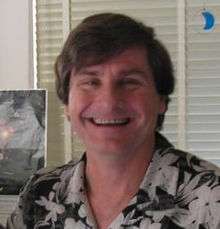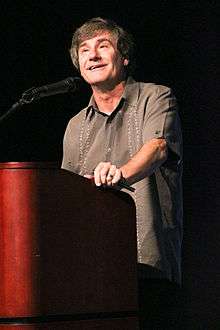Alex Filippenko
Alexei Vladimir "Alex" Filippenko (/fɪlɪˈpɛnkoʊ/; born July 25, 1958) is an American astrophysicist and professor of astronomy at the University of California, Berkeley. Filippenko graduated from Dos Pueblos High School in Goleta, California. He received a Bachelor of Arts in physics from the University of California, Santa Barbara in 1979 and a Ph.D. in astronomy from the California Institute of Technology in 1984, where he was a Hertz Foundation Fellow. He was a Miller Fellow at UC Berkeley and was subsequently appointed to a faculty position at the same institution. He was later named a Miller Research Professor for Spring 1996 and Spring 2005. His research focuses on supernovae and active galaxies at optical, ultraviolet, and near-infrared wavelengths.
Alex Filippenko | |
|---|---|
 | |
| Born | Alexei Vladimir Filippenko July 25, 1958 Oakland, California, United States |
| Education | University of California, Santa Barbara (B.A. 1979) California Institute of Technology (Ph.D. 1984) |
| Known for | Type Ia supernova studies |
| Spouse(s) | Noelle Filippenko |
| Children | 4 |
| Awards | Newton Lacy Pierce Prize in Astronomy Guggenheim Fellowship |
| Scientific career | |
| Fields | Astrophysics |
| Institutions | University of California, Berkeley |
| Thesis | Physical conditions in low-luminosity active galactic nuclei (1984) |
| Doctoral advisor | Wallace L. W. Sargent |
| Other academic advisors | Stanton J. Peale[1] |
Research
Filippenko is the only person who was a member of both the Supernova Cosmology Project and the High-z Supernova Search Team, which used observations of extragalactic supernovae to discover the accelerating universe and its implied existence of dark energy. The discovery was voted the top science breakthrough of 1998 by Science magazine[2] and resulted in the 2011 Nobel prize for physics being awarded to the leaders of the two project teams.
Filippenko developed and runs the Katzman Automatic Imaging Telescope (KAIT), a fully robotic telescope which conducts the Lick Observatory Supernova Search (LOSS), the most successful nearby supernova search. He is also a member of the Nuker Team which uses the Hubble Space Telescope to examine supermassive black holes and determined the relationship between a galaxy's central black hole's mass and velocity dispersion.[3][4] The Thompson-Reuters "incites" index ranked Filippenko as the most cited researcher in space science for the ten-year period between 1996 and 2006.[5]
In the media
Filippenko is frequently featured in the History Channel series The Universe.
Filippenko is the author of and teacher in an eight-volume teaching series on DVD called Understanding the Universe.[6] Organized into three major sections in ten smaller units, this series of 96 half-hour lectures covers the material of an undergraduate survey course for An Introduction to Astronomy (the series' subtitle).
With co-author Jay M. Pasachoff, Filippenko also wrote the award-winning introductory textbook The Cosmos: Astronomy in the New Millennium.[7]
Honors and awards

Filippenko was awarded the Newton Lacy Pierce Prize in Astronomy in 1992 and a Guggenheim Fellowship in 2000. In 1997, the Canadian Astronomical Society invited him to give the Robert M. Petrie Prize Lecture for his significant contributions to astrophysical research. He was also invited to give the 42nd Oppenheimer Memorial Lecture in 2012. He was recognized in the 2007 Gruber Cosmology Prize for his work with then Miller Postdoctoral Fellow Adam G. Riess and for his highly specialized contributions in measurement of the apparent brightness of distant supernovae, which accurately established the distances that support the conclusion of an increasingly rapid expansion of the universe.[8] (Riess shared the 2011 Nobel Prize in Physics for the discovery.)[9] Filippenko was elected to the National Academy of Sciences in 2009. He shared the 2015 Breakthrough Prize in Fundamental Physics with Brian P. Schmidt, Adam Riess, and the High-Z Supernova Search Team.
In addition to recognition for his scholarship, he has received numerous honors for his undergraduate teaching, including the 2007 Richtmyer Memorial Award given annually by the American Association of Physics Teachers and the Carl Sagan Prize for Science Popularization by Wonderfest in 2004.[10] In 2006 Filippenko was awarded the US Professor of the Year Award, sponsored by The Carnegie Foundation for the Advancement of Teaching and administered by the Council for Advancement and Support of Education (CASE).[11] He also won the 2010 Richard H. Emmons Award for excellence in college astronomy teaching, issued by the Astronomical Society of the Pacific.[12] His teaching awards at UC Berkeley include the Donald S. Noyce Prize for Excellence in Undergraduate Teaching in the Physical Sciences[13] and the Distinguished Teaching Award.[14] The UC Berkeley student body has also voted him nine times as their "Best Professor" on campus.[15]
Personal life
Filippenko is married to Noelle Filippenko and has four children, Zoe, Simon, Caprielle, and Orion.[16]
References
- "Alex Filippenko - Acceptance Speech". U.S. Professors of the Year. Archived from the original on October 31, 2014. Retrieved April 4, 2015.
- James Glanz (December 18, 1998). "Breakthrough of the Year: Astronomy: Cosmic Motion Revealed". Science. 282 (5397): 2156–2157. Bibcode:1998Sci...282.2156G. doi:10.1126/science.282.5397.2156a. S2CID 117807831.
- Tod Lauer (14 August 2007). "HST Investigations Into the Central Structure of Galaxies". National Optical Astronomy Observatory. Retrieved 2008-07-17.
- Gebhardt, Karl; et al. (August 2000). "A Relationship between Nuclear Black Hole Mass and Galaxy Velocity Dispersion". The Astrophysical Journal. 539 (1): L13–L16. arXiv:astro-ph/0006289. Bibcode:2000ApJ...539L..13G. doi:10.1086/312840.
- "Top 10 Researchers In Space Science". In-cites. The Thomson Corporation. November 2006. Archived from the original on 2008-02-25. Retrieved 2008-07-17.
- Filippenko, Alex (2007), Understanding the Universe: An Introduction to Astronomy (DVD), The Great Courses (2nd ed.), Chantilly, VA, USA: The Teaching Company
- Pasachoff, Jay M.; Filippenko, Alex (12 Aug 2013), The Cosmos: Astronomy in the New Millennium (4th ed.), New York: Cambridge University Press, ISBN 978-1-107-68756-1
- UC Berkeley news UC Berkeley. 2014. Retrieved 2014-03-17.
- Nobel Prize website The Nobel Prize in Physics 2011. Retrieved 2014-03-17.
- "Sagan Prize Recipients". wonderfest.org. 2011. Retrieved September 10, 2011.
- Robert Sanders (16 November 2006). "Astronomer Alex Filippenko named national Professor of the Year". UC Berkeley News. University of California, Berkeley. Retrieved 2008-07-12.
- "ASP Annual Awards". ASP. 2010. Retrieved 2010-08-22.
- Donald Noyce Prize page Archived 2014-03-13 at the Wayback Machine UC Berkeley. 2014. Retrieved 2014-03-17.
- Distinguished Teaching Award page Archived 2014-03-18 at the Wayback Machine UC Berkeley. 2014. Retrieved 2014-03-17.
- "Alexei V. Filippenko Faculty Page". UC Berkeley. 2012. Archived from the original on 2012-09-30. Retrieved 2012-06-08.
- Pasachoff, Jay M.; Filippenko, Alex (2014) [2001]. The Cosmos: Astronomy in the New Millennium. Cambridge, England: Cambridge University Press. p. xxiii. ISBN 9781107276956.
External links
| Wikimedia Commons has media related to Alexei Filippenko. |
- UC Berkeley Astronomy biography
- UC Berkeley Astronomy website
- Alex Filippenko on IMDb
- Introduction to General Astronomy – UC Berkeley Webcast
- Dark Energy and the Runaway Universe – UC Berkeley Webcast
- Black Holes, Exploding Stars, and the Runaway Universe: A Life in Science (his talk in the Silicon Valley Astronomy Lectures in 2018)